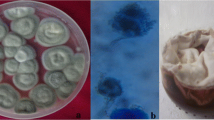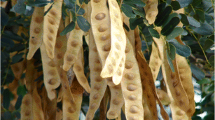Abstract
Microbial control agents offer alternatives to chemical pest control as they can be more selective than chemical insecticides. The present study evaluates the mosquito larvicidal potential of microbial pigment prodigiosin produced by Serratia marcescens NMCC46 against Aedes aegypti and Anopheles stephensi. The pigment of S. marcescens NMCC46 was extracted after 24 h from mannitol containing nutrient broth media. The effects of crude extracted pigment on the growth, survival, development, and other life cycle aspects were studied. The LC50 and LC90 values of second, third, and fourth instars of A. aegypti (LC50 = 41.65, 139.51, 103.95; LC90 = 117.81, 213.68, 367.82) and A. stephensi (LC50 = 51.12, 105.52, 133.07; LC90 = 134.81, 204.45, 285.35) were determined. At higher concentration (500 ppm), mortality starts within first 6 h of exposure. More than 50% mortality occurs within the first 24 h. The overall observed effects against A. aegypti and A. stephensi larvae after 48 h were increasing percent survival larvae, survival pupation, adult emergence with decreasing crude pigment extract concentration. These ensure that the resultant mosquito population reduction is substantial even where the larvicidal potential is minimal. The UV (λ max = 536 nm), TLC (Rf = 0.9), HPLC, and FTIR analysis of crude pigment shows the presence of prodigiosin as active compound. Thus, the active compound produced by this species would be more useful against vectors responsible for diseases of public health importance. This is the first report on mosquito larvicidal activity of prodigiosin produced by Serratia species.







Similar content being viewed by others
References
Abbott WS (1925) A method of computing the effectiveness of an insecticide. J Econ Entomol 18:265–266
Abdel-baky NF, Abdel-Salam AH (2003) Natural incidence of Cladosporium spp. as a biocontrol agent against whiteflies and aphids in Egypt. J Appl Entomol 127:228–235
Amer A, Mehlhorn H (2006a) Larvicidal effects of various essential oils against Aedes, Anopheles, and Culex larvae (Diptera, Culicidae). Parasitol Res 99:466–472
Amer A, Mehlhorn H (2006b) Repellency effect of forty-one essential oils against Aedes, Anopheles and Culex mosquitoes. Parasitol Res 99:478–490
Beatriz M, Navarro S, Pique M, Vilaseca M, Martinell M, Giralt E, Gil J, Peroz-Tomas R (2000) Prodigiosin from the supernatant of Serratia marcescens induce apoptosis in haematopoietic cancer cell lines. Br J Pharmacol 131:585–593
Bennett JW, Bentley R (2000) Seeing red: the story of prodigiosin. Adv Appl Microbiol 47:1
Bond JG, Marina CF, Williams T (2004) The naturally derived spinosad is highly toxic to Aedes and Anopheles mosquito larvae. Med Vet Entomol 18:50–56
Campàs C, Dalmau M, Montaner B, Barragán M, Bellosillo B, Colomer D, Pons G, Pérez-Tomás R, Gil J (2003) Prodigiosin induces apoptosis of B and T cells from B-cell chronic lymphocytic leukemia. Leukemia 17:746–750
Cetin H, Yanikolu A, Click JE (2005) Evaluation of the naturally derived insecticide spinosad is highly toxic to Aedes aegypti L. (Diptera:Culicidae) larvae in septic tank water in Antalya, Turky. J Vector Ecol 30:151–154
Dariot F, Corbel V (2006) Laboratory evaluation of pyriproxyfen and spinosad alone and in combination against Aedes aegypti larvae. J Med Entomol 43:1140–1144
Das K, Mukherjee AK (2006) Assessment of mosquito larvicidal potency of cyclic lipopeptides produced by Bacillus subtilis strains. Acta Tropica 97:168–173
Demain AL (1995) In: Hunter PA, Darby GK and Russel NJ (eds) Fifty years of antimicrobials: past perspectives and future trends. Soc for Gen Microbiol, Cambridge pp 205–228
Elango G, Rahuman AA, Bagavan A, Kamaraj C, Zahir AA, Venkatesan C (2009) Laboratory study on larvicidal activity of indigenous plant extracts against Anopheles subpictus and Culex tritaeniorhynchus. Parasitol Res 104:1381–1388
Finney DJ (1971) Probit analysis. Cambridge University Press, Cambridge pp 76–80
Frustner A (2003) Chemistry and biology of roseopniun and the prodigiosin alkaloids: a survey of the last 2500 years. Angew Chem Int Ed Engl 42:3582–3603
Grimont PAD, Grimont F (1978) The genus Serratia. Annu Rev Microbiol 32:221–248
Inglis GD, Lawrence AM (2001) Effects of Serratia marcescens on the F1 generation of laboratory-reared Heliothis virescens (Lepidoptera: Noctuidae). J Econ Entomol 94:362–366
Jeong HU, Mun HY, Oh HK, Kim SB, Yang KY, Kim I, Lee HB (2010) Evaluation of insecticidal activity of a bacterial strain, Serratia sp. EML-SE1 against diamondback moth. J Microbiol 48(4):541–545
Kamaraj C, Bagavan A, Abdul Rahuman A, Abduz Zahir A, Elango G, Pandiyan G (2009) Larvicidal potential of medicinal plant extracts against Anopheles subpictus Grassi and Culex tritaeniorhynchus Giles (Diptera: Culicidae) Parasitol Res 104:1163–1171
Khanafari A, Assadi MM, Fakhr FA (2006) Review of prodigiosin, pigmentation in Serratia marcescens. Online J Biol Sci 1:1–13
Lacey LA, Undeen AH (1986) Microbial control of black flies and mosquitoes. Annu Rev Entomol 31:265–296
Lysyk TJ, Kalischuk-Tymensen LD, Selinger LB (2002) Comparsion of selected growth media for culturing Serratia marcescens, Aeromonas sp., and Pseudomonas aeruginosa as pathogens of adult Stomoxys calcitrans (Diptera: Muscidae). J Med Entomol 39:89–98
Mandarville RA (2001) Synthesis, proton affinity and anticancer properties of the prodigiosin group of natural product. Curr Med Chem 1:195–218
Mathew N, Anitha MG, Bala TSL, Sivakumar SM, Narmadha R, Kalyanasundaram M (2009) Larvicidal activity of Saraca indica, Nyctanthes arbor-tristis, and Clitoria ternatea extracts against three mosquito vector species. Parasitol Res 104:1017–1025
Mulla MS (1990) Activity, field efficacy and use of Bacillus thuringiensis H-14 against mosquitoes. In: de Barjac H, Southerland DJ (eds) Bacterial control of mosquitoes and black flies: biochemistry, genetics, and applications of Bacillus thuringiensis and Bacillus sphaericus. Rutgers University Press, New Brunswick, pp 134–160
Nakashima T, Kurachi M, KatoY YK, Oda T (2005) Characterization of bacterium isolated from the sediment Coast area of Omura Bay in Japan and several biological activities of pigment produced by this isolated. Microbiol Immunol 49:407–415
Nobutaka S, Masami N, Kazuyuki H, Tadaaki H, Katsumi A (2001) Synergistic antifungal activity of chitinolytic enzymes and prodigiosin produced by biocontrol bacterium, Serratia marcescens strain B2 against gray mold pathogen, Botrytis cinerea. J Gen Plant Pathol 67:312–319
Nunez-Valdez ME, Calderon MA, Aranda E, Hernandez L, Ramirez-Gama RM, Lina L, Rodriguez-Segura Z, Gutierrez MC, Villalobos FJ (2008) Identification of a putative Mexican strain of Serratia entomophila pathogenic against root-damaging larvae of Scarabaeidae (Coleoptera). Appl Environ Microbiol 74:802–810
Okamoto H, Sato M, Sato Z, Isaka M (1998) Biocontrol of Phytophthora capsici by Serratia marcescens F-1-1 and analysis of biocontrol mechanisms using transposon-insertion mutants. Ann Phytopathol Soc Jpn 64:287–293
Pandey R, Chander R, Sainis KB (2007) Prodigiosin: a novel family of immunosuppressants with anti-cancer activity. Indian J Biochem Biophys 44:295
Patil CD, Patil SV, Salunke BK, Salunkhe RB (2010a) Bioefficacy of Plumbago zeylanica (Plumbaginaceae) and Cestrum nocturnum (Solanaceae) plant extracts against Aedes aegypti (Diptera: Culicide) and nontarget fish Poecilia reticulata. Parasitol Res. doi:10.1007/s00436-010-2174-6
Patil SV, Patil CD, Salunke BK, Salunkhe RB (2010b) Larvicidal efficacy of six plants against two mosquito species Aedes aegypti and Anopheles stephensi. Trop Biomed 27(3):360–365
Paul A, Harrington LC, Scott JG (2006) Evaluation of novel insecticides for control of dengue vector Aedes aegypti (Diptera:Culicidae). J Med Entomol 43:55–60
Priyanka, Srivastava JN, Prakash S (2001) Chrysosporium tropicum efficacy against Anopheles stephensi larvae in the laboratory. J Am Mosq Control Assoc 17:127–130
Promsiri S, Naksathit A, Kruatrachue M, Thavara U (2006) Evaluations of larvicidal activity of medicinal plant extracts to Aedes aegypti (Diptera: Culcidae) and other effects on a non target fish. Insect Sci 13:179–188
Rahuman AA, Gopalakrishnan G, Venkatesan P, Geetha K (2008) Isolation and identification of mosquito larvicidal compound from Abutilon indicum (Linn.) sweet. Parasitol Res 102(5):981–988
Rahuman AA, Bagavan A, Kamaraj C, Saravanan E, Zahir AA, Elango G (2009) Efficacy of larvicidal botanical extracts against Culex quinquefasciatus Say (Diptera: Culicidae). Parasitol Res 104:1365–1372
Sagar SK, Sehgal SS (1997) Toxicity of neem seed coat extract against mosquitoes. Indian J Entomol 59(2):215–223
Salunkhe RB, Patil SV, Patil CD, Salunke BK (2011) Larvicidal potential of silver nanoparticles synthesized using fungus Cochliobolus lunatus against Aedes aegypti (Linnaeus 1762) and Anopheles stephensi Liston (Diptera; Culicidae). Parasitol Res. doi:10.1007/s00436-011-2328-1
Senthilkumar N, Varma P, Gurusubramanian G (2009) Larvicidal and adulticidal activities of some medicinal plants against the malarial vector, Anopheles stephensi (Liston). Parasitol Res 104:237–244
Shaalan EAS, Canyonb D, Younesc MWF, Abdel-Wahaba H, Mansoura AH (2005) A review of botanical phytochemicals with mosquitocidal potential. Environ Int 31:1149–1166
Sharma P, Mohan L, Srivastava CN (2009) Amaranthus oleracea and Euphorbia hirta: natural potential larvicidal agents against the urban Indian malaria vector, Anopheles stephensi Liston (Diptera: Culicidae). Parasitol Res 106:171–176
Sikorowski PP, Lawrence AM (1998) Transmission of Serratia marcescens (Enterobacteriaceae) in adult Heliothis virescens (Lepidoptera: Noctuidae) laboratory colonies. Biol Control 12:50–55
Singlton P, Sainsbury D (2001) Dictionary of microbiology and molecular biology, 3rd edn. John Wiley and Sons Ltd.
Someya N, Kataoka N, Komagata T, Hirayae K, Hibi T, Akutsu K (2000) Biological control of cyclamen soilborne diseases by Serratia marcescens strain B2. Plant Dis 84:334–340
Song MJ, Bae J, Lee DS, Kim CH, Kim JS, Kim SW, Hong SI (2006) Purification and characterization of prodigiosin produced by integrated bioreactor from Serratia sp. KH-95. J Biosci Bioeng 101:157–161
Soto-Cerrato V, Viñals F, Lambert JR, Pérez-Tomás R (2007a) The anticancer agent prodigiosin induces p21WAF1/CIP1 expression via transforming growth factor beta receptor pathway. Biochem Pharmacol 74(9):1340–1349
Soto-Cerrato V, Viñals F, Lambert JR, Kelly JA, Pérez-Tomás R (2007b) Prodigiosin induces the proapoptotic gene NAG-1 via glycogen synthase kinase-3beta activity in human breast cancer cells. Mol Cancer Ther 6(1):362–369
Sparks TC, Thompson GD, Kirst HA, Hertline MB, Mynderse JS, Turner JR, Worden TV (1998) Fermentation derived insecticides control agent: the spinosyns. In: Hall FR, Menn JJ (eds) Biopesticides, use and delivery. Humana, Totowa, pp 676–188
Steinhaus EA (1959) Serratia marcescens Bizio as an insect pathogen. Hilgardia 28:351–380
Vyas N, Dua KK, Prakash S (2007) Efficacy of Lagenidium giganteum metabolites on mosquito larvae with reference to nontarget organisms. Parasitol Res 101:385–390
Wai YH, Chen WC (2005) Enhanced production of prodigiosin-like pigment from Serratia marcescens SMAR by medium improvement and oil-supplementation strategies. J Biosci Bioeng 99:616–622
Walton WE, Mulla MS (1992) Impact and fates of microbial pest control agents in the aquatic environment. In: Rosenfield A, Mann R (eds) Dispersal of living organisms into aquatic ecosystems. Maryland Sea Grant College, University of Maryland, College Park, pp 205–237
Weiser J, Matha V, Zizka Z, Jegorov A (1992) Ultrastructural changes in Culex pipiens larvae treated with tolypin, the insecticidal metabolite of Tolypocladium inflatum Gams (Deuteromycetes). Cytobios 69:179–186
WHO (1996) Report of the WHO informal consultation on the evaluation on the testing of insecticides CTD/WHO PES/IC/96.1:69
Williamson NR, Fineram PC, Leeper FJ, Salmond GPC (2006) The biosynthesis and regulation of bacterial prodiginines. Nat Rev Microbiol 4:887–899
World Health Organization (1982) Biological control of vectors of disease. Sixth report of WHO Expert Committee on Vector Biology and Control 679:1–39
Zebitz CP (1986) Effect of three different neem seed kernel extracts and azadirachtin on larvae of different mosquito species. J Appl Entomol 102:422–463
Zizka J, Weiser J (1993) Effect of beauvericin, a toxic metabolite of Beauveria bassiana, on the ultrastructure of Culex pipiens autogenicus larvae. Cytobios 75:13–19
Author information
Authors and Affiliations
Corresponding author
Rights and permissions
About this article
Cite this article
Patil, C.D., Patil, S.V., Salunke, B.K. et al. Prodigiosin produced by Serratia marcescens NMCC46 as a mosquito larvicidal agent against Aedes aegypti and Anopheles stephensi . Parasitol Res 109, 1179–1187 (2011). https://doi.org/10.1007/s00436-011-2365-9
Received:
Accepted:
Published:
Issue Date:
DOI: https://doi.org/10.1007/s00436-011-2365-9




